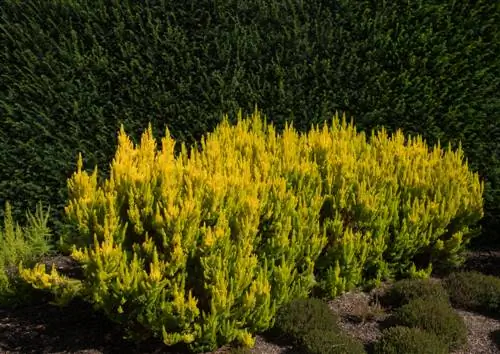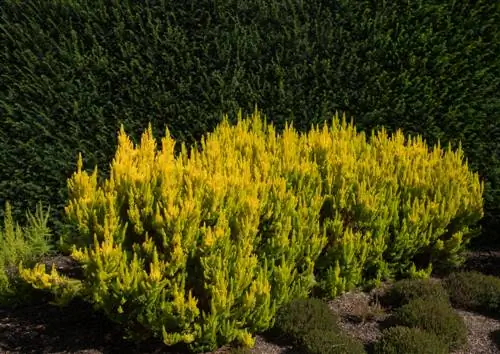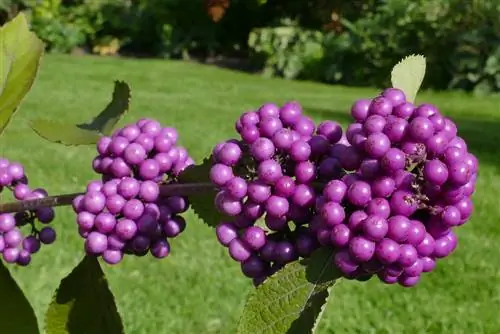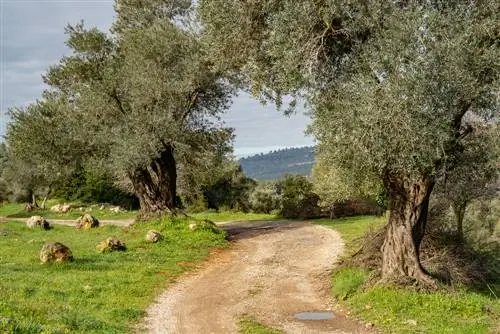- Author admin [email protected].
- Public 2023-12-16 16:46.
- Last modified 2025-01-23 11:21.
Not everyone is familiar with the tree-shaped heather. Anyone who likes to travel to Mediterranean regions will certainly be familiar with the plant. You can also cultivate the largest type of heather in this country - the rustic beauty is definitely a win!

What is a tree heather and how do you care for it?
The tree heather (Erica arborea) is a tree-like shrub that comes from Mediterranean regions and can grow up to 6 meters high. It prefers acidic, humus-rich soils, sunny locations and can tolerate light frost. Its white, fragrant flowers appear from the end of winter to June.
Origin
The tree heather (erica arborea) is exactly what its name suggests: a tree-like species within the heather plant genus (Erica). In fact, the tree resembles a larger version of the well-known winter or summer heather. While the latter are very popular in local gardening, tree heather bushes are rarely seen in this country. This may be mainly because they come from warm Mediterranean regions and are only partially hardy in our northern latitudes.
In its native areas, the entire Mediterranean region including the Canary Islands, Madeira and the Central African highlands, the tree heath has a major influence on the respective landscape. Like all Erica, the tree heather thrives in stony, poor areas. It is particularly common in forest areas and maquis with acidic soils.
In northern Central Europe, tree heather can certainly be cultivated, but a significantly lower height must be expected. Due to limited frost tolerance, it may also be advisable not to plant outdoors.
Origin at a glance:
- Tree heather is a tree-like growing type of heather herbs
- Comes from the entire Mediterranean region, the Canary Islands, Madeira and Central Africa
- Cannot really be cultivated outdoors in this country due to moderate frost tolerance
Growth
The tree heather develops a habit that can be classified between a shrub and a tree. In most of its regions of origin it grows to a height of around 6 meters, on La Gomera even up to 20 meters. In our case, however, due to the cooler and less light climate, it ends at around one meter.
The tree forms dense branching with its initially light, hairy and later red-brown barked shoots, which grow into a bushy crown.
leaves
Narrow, needle-like leaves about half a millimeter wide and about 5 millimeters long grow on the bushy, branched shoots. In most species the leaves are dark green in color, but some cultivars also have other foliage colors such as lime yellow. These can be used to add cheerful splashes of color to the garden all year round.
Leaf properties at a glance:
- Needle-like, approx. 5 mm long leaves
- Mostly dark green color, but other colored cultivars also available
Flowers
From the end of winter until June, many small, white flowers, arranged in groups, appear on the branches with an elongated, closed cup shape and a single protruding stamen. With their lushness and white color, they not only stand out beautifully against the dark foliage, but also exude a lovely, honey-like scent. However, a heather bush only produces its first flowers after a few years.
Flower properties in brief:
- First flowers only after a few years
- Flowering period from the end of winter until June
- Cupular shape, white color, lush group position
- Pleasant honey-like scent
Which location is suitable?
In its home regions, the tree heather enjoys a lot of sun and therefore needs a location that is as sunny as possible in our rather darker latitudes. If you want to plant them outdoors, make sure that the sun reaches the spot at all times of the day if possible. If you keep the shrub in a pot, a free space on a south-facing terrace or a south-facing balcony is ideal.
A critical factor in outdoor cultivation is of course frost, which is somewhat harsher in exposed locations. A few low trees in a not too distant neighborhood are therefore not a bad idea.
- Tree heather should be given as sunny a spot as possible
- Parking space on the south terrace is ideal in the bucket
- Do not plant too exposed due to frost sensitivity
What soil does the plant need?
The tree heather is one of those heather species that prefer acidic soil. The planting soil should also be humus and not too compact. Add a good amount of sand to the substrate, and a good amount of compost is also a good idea. To specifically acidify the pot soil, you can use peat and a little vinegar. If you want to plant the shrub outdoors, loosen the planting hole well beforehand.
To remember:
- Substrate for tree heather should be acidic and humic
- Loose the soil with sand content and enrich it with compost
- Acidify pot soil with peat and vinegar if necessary
Watering tree heather
In spring, when the tree heather gets into growth mode, you should provide it with good water. However, only to the extent that the planting ground does not dry out completely. The soil should never be too wet, as the shrub comes from regions that are generally rather dry. It is important - especially if you keep the tree heather in a pot - that you use low-lime water, ideally from a rain barrel, depending on your preference for an acidic soil environment.
Casting practice in keywords:
- Water regularly, especially in spring during the growth phase
- Otherwise rather moderate, just don't let it dry out
- Use as soft (rain) water as possible
Fertilize tree heather properly
Since the tree heather thrives on acidic soil, special fertilizers, such as preparations for rhododendrons, are suitable to support its growth. However, fertilization should be carried out in moderation and only during the main vegetation phase from spring through summer. For long-term care, you can add a good amount of compost to the planting base or pot substrate.
Fertilizer recommendation coming soon:
- Use special fertilizer, such as for rhododendrons
- Use compost as a long-term supply
- Additional fertilization only during the main vegetation phase
Cut tree heather correctly
Regular pruning care is definitely recommended for tree heather if you value compact, shapely growth. This also applies to all other types of heather that are cultivated in the garden. It is best to carry out the shaping pruning in early winter, before the flowers begin. After flowering in July or August, further pruning is advisable so that a beautiful abundance of flowers can develop the following year.
Pruning care in brief:
- Regular pruning is recommended for compact growth
- Shaping pruning in winter
- Flower-promoting pruning in summer after flowering
Wintering
Wintering is an important chapter for tree heather. Since it doesn't withstand our winters, the Erica fan has to decide when planting whether he can be responsible for outdoor cultivation or whether he would prefer to rely on the safer, more mobile container culture.
In mild regions, planting outdoors is certainly possible if appropriate protective measures are taken during longer periods of frost. In areas where the thermometer can drop below -10°C for long periods of time in winter, it is better to avoid outdoor cultivation. If you have decided to plant it permanently in the garden, you should cover the shrub with fir branches and/or garden fleece when temperatures fall below 0°C.
If a heather bush has largely frozen back in winter, you don't have to give it up immediately. Wait until spring, radically cut back the frozen material and wait to see whether the plant sprouts again. This is certainly possible under favorable conditions.
If you keep the tree heather in a bucket, you are of course more flexible when it comes to overwintering. In the fall, when temperatures consistently reach single digits, simply place them in a cool, but as bright place as possible. A cold house is best, but an unheated entrance veranda or a garden house with a window are also good places to overwinter. The temperature in the winter quarters should be around 5°C. During the wintering period, only water the tree heather enough to prevent it from drying out.
Wintering rules in keywords:
- Can be overwintered outdoors in milder regions
- Then cover with fir branches and/or garden fleece in severe frost periods with permanent negative temperatures
- If kept in a container, place it in a bright, cool (around 5°C) place in autumn (cold house or garden house)
Tip
In pot culture, a tree heather shrub looks particularly decorative in a basket planter. The wooden weave emphasizes the rustic character of the tree heather and its shrubby habit. Several varieties with different colored leaves look very pretty in a group position.
Varieties
Erica have recently become extremely popular again and are being bred eagerly for marketing. Winter and summer heath in particular are on the rise. But there are now numerous different varieties of tree heather that offer the hobby gardener creative freedom. Here too, varieties with foliage of a different color than the original dark green have enriched the market.
Erica arborea 'Albert's Gold'
This tree heather variety has a golden, lime-yellow foliage that provides a distinctive color accent in the garden or on the terrace all year round. The foliage color looks particularly beautiful in contrast to the reddish-brown bark that shines through between the needle-like leaves. The tree heather 'Alberts Gold' grows to a maximum height of one meter and is relatively tolerant of single-digit minus temperatures. It can therefore be planted in a heather garden in milder regions. But it also looks good in terracotta pots and is particularly decorative on natural stone slabs.
Erica arborea 'Estrella Gold'
This variety also has yellow foliage, but in a slightly warmer, softer tone. The 'Estrella Gold' also grows to almost a meter high. It is somewhat more sensitive to frost, which is why pot culture is preferable to planting it outdoors. Throughout the first half of the year it delights with fragrant blossom magic.
Erica arborea ‘Alpina’
The tree heather 'Alpina' has bright, fresh green foliage and is particularly attractive in combination with pink-flowering rhododendrons. Its leaves have a particularly fine, almost feathery structure, which is why the variety also looks good in the Japanese rock garden. A beautiful structural contrast can be created in rustic basket planters. The variety grows to a height of 80 to 100 cm and is hardy down to single-digit temperatures below zero.






